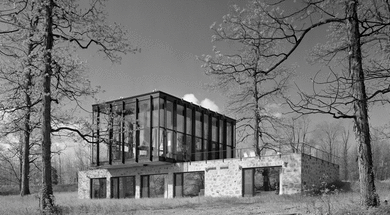A Critique of Architectural Art Philip Johnson, Robert C. Wiley House, Connecticut, 1953. Philip Johnson, Robert C. Wiley House, Connecticut, 1953. It is possible to argue that architecture is essentially a response to complexity, since architecture and design, generally, imply the resolution of manifold elements in a unified whole. Design can be seen as a means of economization, the process of making one thing serve two purposes through (clever) manipulation. Architecture is this project on a grand scale. From the most abstract aesthetic ideals to the most technical engineering requirements to the most mundane supply chain logistics, all the while fixed in a web of interpersonal dynamics, not to mention historical and ecological contexts, almost nothing is exempt from consideration. If we postulate this (the resolution of complexity) as a defining characteristic of architecture, then Venturi’s rebuke of minimalism as instantiated by the likes of Mies and Philip Johnson is among the most exigent challenges to an architecture that had begun to shift toward a form of space-enclosing sculpture and away from life-enabling building. “Mies,” Venturi writes quoting Paul Rudolph, “makes wonderful buildings only because he ignores many aspects of a building. If he solved more problems, his buildings would be far less potent” (16). Similarly, Venturi writes of Johnson’s Wiley House, “the building becomes a diagram of an oversimplified program for living” (17). It is Johnson’s crystalline facsimile of life which is enshrined in that glass box: a fantasy. And it is Mies’ willful blindness that plagues much of "modern" architecture. Venturi’s eye is trenchant. When the architect decides what to address, moreover what to exclude, he or she is making a judgment about what is important to those people who will interact with the building in the future. Accordingly, if what is ultimately prioritized is some form of expression (minimalist or not), especially insofar as what is expressed relates to the building (e.g. material honesty, or as Christopher Alexander says, some "literary comment"*), the structure becomes a self-referential statement about architecture, not something that exists in use and in the last measure to serve its occupants. My argument begins with this fundamental premise: that architecture is for people.** This is the source of its complexity, as life is everything but an abstraction. Venturi reminds us that if architecture is to be valid, its success will come from the resolution of the intricate, competing demands of a purposive object embedded in the world, not from an indifference to, rejection of, or even reflection upon these conditions. This last part is my own. To put it one way: the ideal of expression in architecture stands opposite to life. Or again: architecture that is about itself, especially that which advertises this self-conscious relationship as a badge of rarified aesthetic or other ideological integrity, is paradoxically not functioning as architecture at all. *From his infamous 1982 debate with Peter Eisenman at the GSD. **We must also resolve the semantic argument concerning the meaning of the word ‘architecture.’ ***Citations from Robert Venturi, Complexity and Contradiction in Architecture, Museum of Modern Art, NY (2002). *
Comments are closed.
|
WritingArchives
January 2021
Categories
All
|
